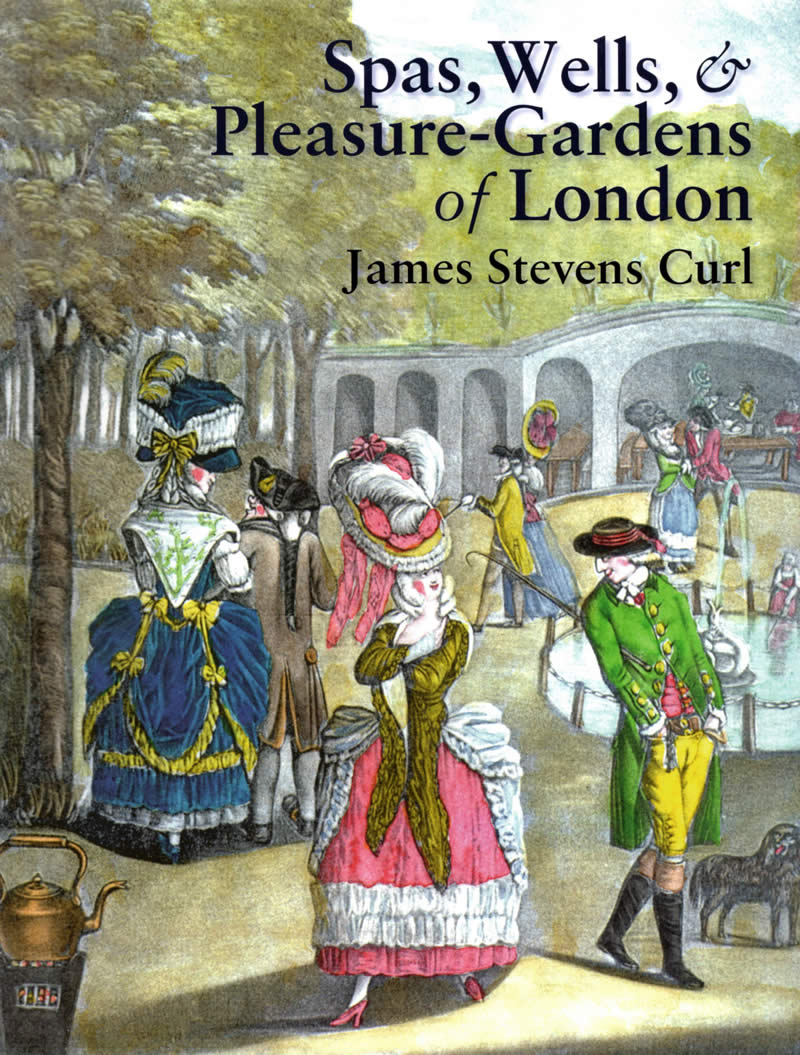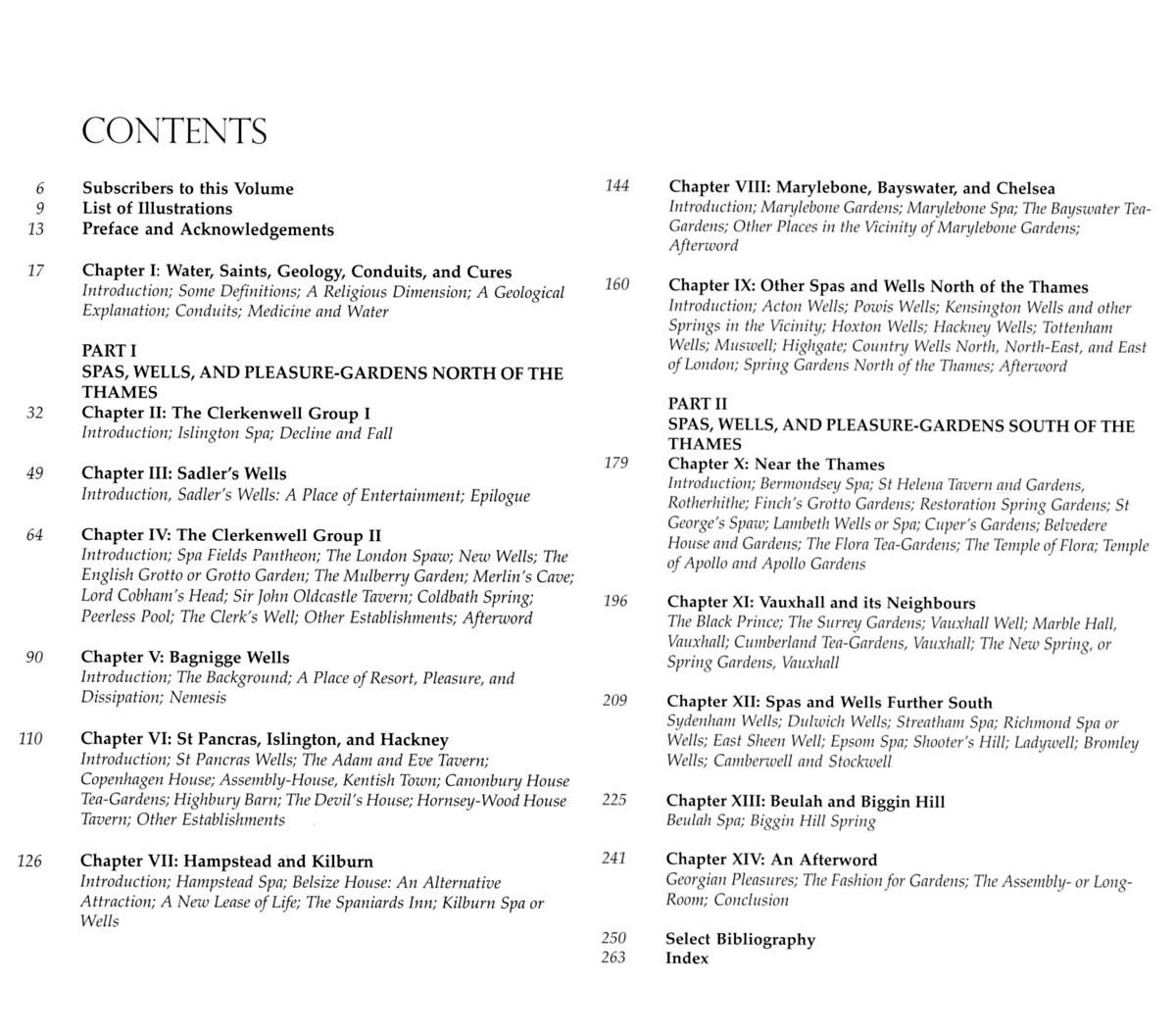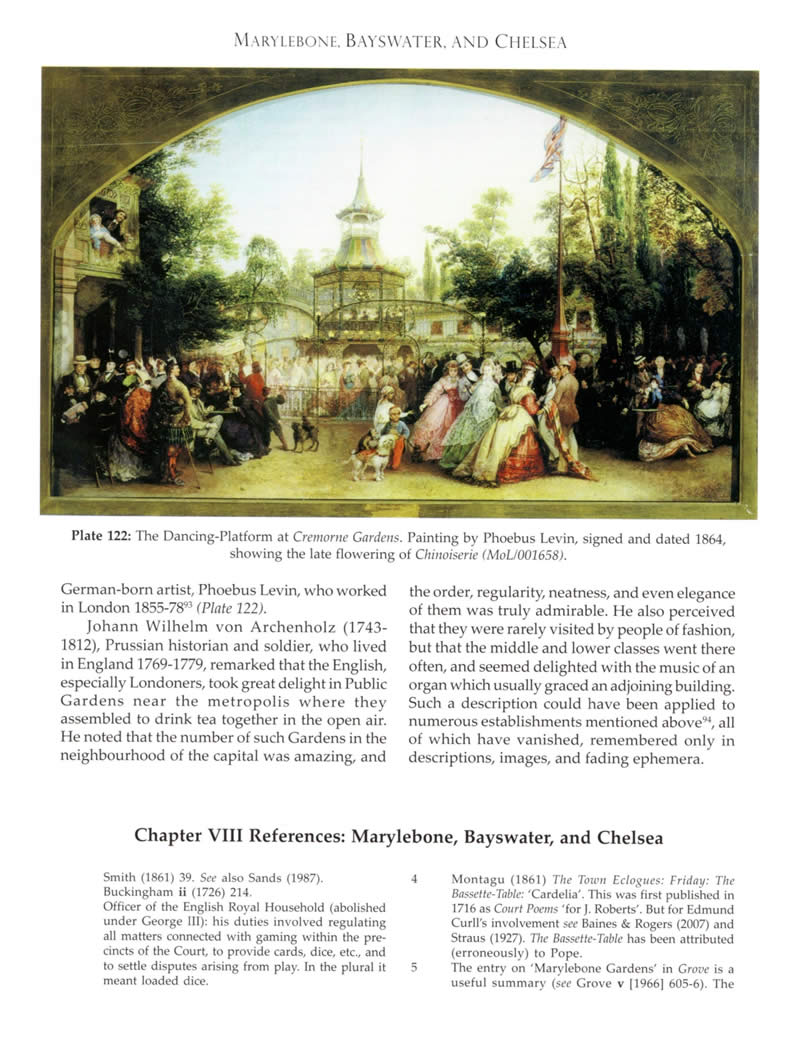Spas, Wells, & Pleasure-Gardens of London

Author : James Stevens Curl
Publisher : London: Historical Publications Ltd., 2010
ISBN:978-1-905286-34-8 (hbk)
London was once blessed with Spas set in gardens, where beneficial waters could be enjoyed in agreeable surroundings, sometimes with music, food, and alcohol. They were, in effect, the pleasure-resorts of the 18th century, and proved to be the origins of more elaborately ornamented gardens (such as those of Ranelagh and Vauxhall), where water was employed for show rather than for consumption.
This comprehensive account of the Spas, Wells, & Pleasure-Gardens that attracted London Society at all levels from the 17th to the 19th century, is decorated with numerous splendid illustrations (many in colour). It ranges from simple medicinal wells, such as that at Sydenham, to celebrated Spas such as Bagnigge, Islington, and Beulah. It then proceeds to the many tea- and pleasure-gardens that provided entertainment and relaxation distanced from the insalubrious London air, all enlivened with vivid period anecdotes.
The definitive account of a long-lasting but ephemeral feature of London life.
Reviews
‘What pleasures lurk within the pages of Curl’s latest tome! .... Set amid the gardens, streams, and arbors of the English countryside, the book explores the tradition, much in vogue...during the eighteenth century, of taking curative waters in establishments that catered to many assorted convivial pursuits. It is a carefully documented study of the design of such complexes, interwoven with a wealth of information about the period’s social history and its underlying myths, affectations, customs, and vices. ... Among the close to 200 stunning images of maps, theater programs, songs, and verses, there are also many aquatints and engravings, hand-colored... fine-line drawings of idyllic vistas, caricatures, advertisements, title-pages, and photographs that bring the eighteenth century vividly to life. Curl...ventures further into the territory of sociological reflection to offer a most eloquent treatise on one of the Enlightenment’s more ephemeral manifestations ….'
‘...this new book, by the distinguished scholar and architectural historian James Stevens Curl, ...adds a new dimension by approaching the subject from the angle of “beneficial” waters. It concentrates primarily on sites where there was natural water--spas and wells-- but, as the author explains, because the common denominator was a garden, tea-gardens and pleasure-gardens were brought into the survey... The result is an astonishing compilation teeming with information and anecdote, and illustrated with 194 plates (some in colour), many of which are little known or previously unknown. The images contain both focused views and maps and broader prospects. Spas, Wells, & Pleasure-Gardens of London was forty years in the making and stands as a considerable achievement... There is a cornucopia of good stories: the author’s hope that the book will prove “moderately entertaining” is too modest. But it is also a thorough and properly scholarly study... Overall the book is fascinating and a good read, and a salutary reminder of the eternal gullibility of the public and their susceptibility to advertising.’
‘The title refers to London but in fact a sizable chunk of this work, more than half, relates to the social history of Islington and its close environs from the seventeenth to the nineteenth centuries. It is almost literally a lifetime’s work, … having been conceived in the then Empress of Russia P.H. in St John Street more than forty years ago... There is a huge bibliography..., but this is the first attempt to draw all the material covered by this wide ranging title into a single volume and to support it with more copious illustrations than its predecessors have mustered. The long gestation period has ensured that errors of fact which may have crept into previous works are now corrected...This is a work without which any library of Islington’s past would not be complete.’
‘The indefatigable ....Curl has produced yet another invaluable work, the third to be reviewed in these pages in recent years...As well as increasing your knowledge of the social mores of the eighteenth and nineteenth centuries, reading Professor Curl will also greatly enlarge your vocabulary....lastly, a word about the wealth of well-reproduced illustrations....Curl has brought together a fascinating collection ranging from topographical views to play-bills and many show the characters who frequented these places of recreation. These alone would provide an endless sources of information and inspiration.'
‘Curl has written extensively on architecture, ... cemeteries, and the celebration of death. Now he turns his considerable knowledge to the spas, wells, and pleasure-gardens of London from the seventeenth to the nineteenth century. Written in a comprehensive, scholarly way, ... [his] account of the watering-holes and pleasure-gardens from the Restoration to Victorian times is a vital part of London’s health and social history... [His work] should be on every London historian’s bookshelf...’
‘Curl is an architectural historian with a prodigious output behind him, covering a vast spectrum of subjects both in time and place. Now in his eighth decade, as he ruefully admits, he has turned his attention to a London subject which first grabbed his enthusiasm over forty years ago....[His] exhaustive quest has been to bring together information covering the whole of modern London, so his survey encompasses such places as Acton, Bromley, Tottenham, Kilburn, Richmond, and Norwood... His book is a great achievement … which it is hard to see being surpassed ... The illustrations are wonderful and varied and number nearly 200. They give a vivid picture of a lively leisure world once enjoyed by Londoners.'
‘This groundbreaking book is a study of an astonishing 59 or more spa gardens within the grim, sooty bounds of London and its Home Counties suburbs, the capital’s answer to contemporary eclectic Arcadian landscapes… Its 198 illustrations, many in colour, … will give active readers the pleasure of relating the reservoirs and spires of contemporary engravings to the maze of city streets. It will also encourage readers to become spa hunters, treating with new respect the ill-smelling premises of London’s countless pubs and converted theatres…. But the book’s real value for the general reader lies in the endlessly changing variety of what the spa gardens offered. That creative, scabrous, bawdy, hard-drinking culture explains the English character today in all its eccentric diversity. The spa gardens took over where the Elizabethan theatre left off, easing a constrained and stratified class structure into a togetherness where everyone, from royalty to pickpockets, cultural elitists to whores, and deviants to hypochondriacs, could dance, wrestle, play ball games and, above all else, get enjoyably drunk together and indulge in sexual encounters.’
‘Looking for spas in London may sound like….a project as bootless as the proverbial search for a cab south of the river. It takes a scholar of determination to track them down, and that is exactly what James Stevens Curl has done, providing for spas and wells the same service he did for the great, yet then overlooked Victorian necropoleis in his definitive work on The Victorian Celebration of Death (1972)… Curl takes the reader on an ale-, tea-, and arrack-fuelled journey through more than eighty resorts that flourished in the seventeenth-, eighteenth-, and nineteenth-century city … this work will be of considerable value to historians of London and of leisure, of interest to anyone who has wondered about the “wells” whose names are familiar yet also somewhat mysterious, from Camberwell to Clerkenwell.’
‘Curl has tackled the fascinating topic of the Spas, Wells, & Pleasure-Gardens of London in his latest book: the result … is as informative and well researched as you would expect from such an author, but also as racy and humorous as you would expect from such a topic...One of the author’s achievements...is to make us feel sad that we lack something as colourful and as inventive in the modern age ... ; another is to bring back to life in page after page of vivid writing the sounds, smells, sights and atmosphere, the artifice and personalities, the beauty and the ugliness of what he sums up as "these remarkable, lively, often lovely, and rarely dull places of entertainment" .'
‘Curl … started writing about Spas for Country Life four decades ago, and no one can possibly know more than he has packed into this book … Spas is beautifully produced: it is sewn, bound in real cloth, and printed on glossy paper to favour the 194 illustrations, many of them from old hand-coloured prints and from the author’s collection. The text is elegant, opinionated, amusing, and utterly immune to postmodern influences. It is the kind of scholarly writing in which British academics used to excel, that turns erudition into a high form of entertainment.'




 LinkedIn
LinkedIn  Wikipedia
Wikipedia